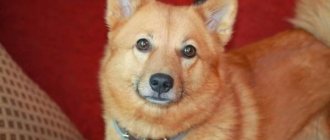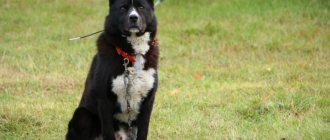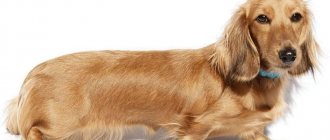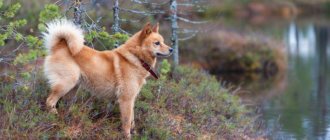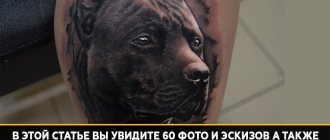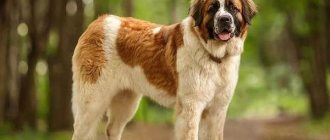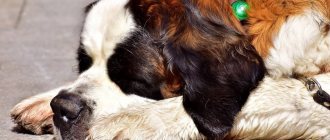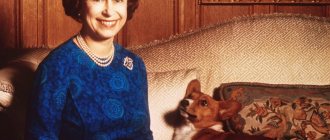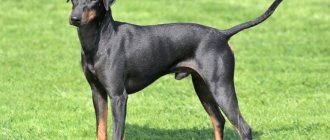Care and maintenance
The Karelian dog, like all aboriginal animals, has excellent health.
Nature has endowed her with strong immunity and endurance. She does not require special care. It is enough to comb her thick fur a couple of times a week, wipe off dust with a damp cloth, monitor the condition of her teeth and ears, and visit the dentist if necessary.
The dog does not have a specific dog smell and does not require frequent bathing. Wash it as it gets dirty with special dog shampoos no more than once every six months. A spacious enclosure is more suitable for keeping her.
The dog does not like confined spaces and needs constant physical activity. An hour's walk twice a day is not enough for him. In an apartment he will feel uncomfortable and bored. He needs fresh air and space. It tolerates both heat and cold equally well.
Under heavy loads, Karelian claws usually grind down on their own and cannot be trimmed. She does not suffer from eye diseases. If your eyes become sour, it is enough to rinse them with tincture of chamomile decoction.
Training and education
Karelka has an independent character. Therefore, it is quite difficult to train her. She does not tolerate violence against herself, she is very stubborn. It requires an individual approach, which not every amateur can handle. In this case, it is better to contact a professional dog handler.
Like any animal, a bear dog must be taught socialization from an early age so that the dog can calmly accept people, dogs of other breeds, and does not rush at cats. It is necessary to develop hunting abilities in a bugbear dog and master a SKD course.
Attention! For his pet, the owner must be an authority who must be obeyed unquestioningly. Games of two bugbears
Education and training
Training your Karelian Laika should begin from the first day it arrives in your home. The dog’s character is quite specific, so you should never waste time. Dog breeders do not recommend getting this breed for people who are getting a dog for the first time; it is better if they have at least modest experience in raising and training hunting dogs
A Karelian has an independent, freedom-loving, self-sufficient disposition; it is important from the first acquaintance to put oneself in charge with a firm hand. The dog must clearly understand who is the owner, who to obey and initially be within the boundaries of what is permissible
There is no need to teach your dog hunting skills, since these skills are genetically inherent in him
The most important thing is to form a clear habit of acting on command and only after it. This is the most difficult moment in training Karelians
If a person can initially show himself as the owner and gain a foothold in this position in the dog’s mind, there should be no problems in training.
Besides this, there is another difficulty in raising a Karelian - the overly developed instinct of a hunter pulls him into the wild. This problem will be solved by systematic training and perseverance. Dog handlers warn against assault during training: cruelty, aggressive behavior, swearing, screaming do not affect the dog the way you want it to. Rather, the effect will be the opposite: the dog will become angry, aggressive, disobedient, and stubborn.
Walking your dog is an excellent educational tool and should be done at least twice a day. Control over the dog at this time makes it possible to once again demonstrate who is boss in the house. It is best if you walk your dog in a muzzle from the first days, walk in different areas so that the dog learns to navigate and gets acquainted with the diversity of the surrounding world.
At first, the dog is walked on a leash. She will need to get used to it, in addition, this way she will be under control. After the dog is trained, in a forest area you can give him the opportunity to walk without a muzzle and a leash. At the very beginning of your relationship, the dog simply will not listen and will start running after birds and cats, despite your protest.
The owner's responsibilities include:
- development of hunting skills;
- sharpening them regularly;
- refusal of physical force unless absolutely necessary;
- socialization of the dog, that is, gradual accustoming to other animals, since the husky perceives them all as prey;
- Do not entrust the training of the dog, otherwise it will not recognize the owner.
To develop hunting skills, the following are important:
- clear and complete mutual understanding;
- confident execution of commands;
- fixation of basic commands in the dog’s mind, it must run forward, approach the owner, run back, unquestioningly obeying;
- knowledge of the owner’s intonations, the ability to respond correctly;
- calmness during shots and other distracting events;
- search skills;
- orientation skills;
- ability to distinguish traces;
- confident fetch.
In other countries, the dog is often trained to perform highly specialized tasks, such as scaring away bears. However, the main purpose of the dog is universal hunting. Weather conditions are not important for them; the dogs are very hardy. Be sure to take into account the fact that Karelians are extremely fearless, they are not afraid to come close to predators, so they often die while hunting.
For more information about the Karelian bear dog, see the following video.
Hunter's Purpose
The process is different from hunting with other representatives of four-legged animals. The Karelian dog is a generalist, he works not only with small game, but also with large predators: elk, wild boar, bear, bison.
Increased endurance and excellent performance help her even against large and dangerous bears. She is careful, does not come close, and stubbornly drives him to the place where he will wait for the owner. Bad weather conditions or dense, swampy forests are not scary for her. I see the goal - I see no obstacles.
You should be careful, do not let go of a significant distance, be nearby. Due to the lack of fear and natural excitement, they can sometimes go too far, which provokes predators to quickly defend themselves. There is a possibility of damage, so be close and take quick action.
Education and training
Only the owner or dog handler should raise and train bear cubs under his strict supervision. The course of protective guard service is contraindicated for Likes, as it can provoke the manifestation of anger.
From an early age, your pet needs to be socialized. In the city, the baby is taught to wear a muzzle and a leash, but in rural conditions they develop a calm attitude towards domestic animals.
When raising a puppy, it is necessary to strengthen its natural hunting inclinations. To do this you need:
- clear interaction with the owner;
- show rigor and be patient;
- accustom to the sound of a gunshot and distracting sounds;
- teach the correct reaction to the owner’s intonation;
- teach basic commands: “No!”, “Back!”, “Forward!”, “Come to me!”;
- clearly state the command “No!”;
- train the orienting instinct;
- teach how to perform the “Aport!” command.
By the age of seven months, the pet should decide on its specialization, that is, who it will hunt. This could be swamp or pine forest game, fur-bearing animals, bears, or large ungulates.
Pet care
Since the breed is intended for living and working in conditions of hunting and wild nature, it does not require specific care and is unpretentious. By following the rules of nutrition and providing the necessary activity, the animal will remain healthy.
Behind the wool
The coat of such dogs is short and dense, and, therefore, it practically does not tangle. The molting period is quite abundant and occurs twice a year.
For combing, use a metal comb or brush, and during periods of intense hair loss and change of hair, it is recommended to use a furminator.
Important! Individuals of the Karelian Laika breed do not have the traditional smell of dogs, and therefore there is an opinion that they are hypoallergenic. However, their undercoat is quite dense and is subject to shedding twice a year, and dust particles from the down coat can aggravate an allergic reaction.
Bathing
You don't have to bathe the animal to remove dirt from your dog's fur. The husky's coat is very dense and not long, and you can get by with removing traces of dirt by wet wiping.
It does not have a strong odor when wet and without bathing. You can bathe her 2-4 times a year and this will be enough (subject to regular participation in exhibitions).
Inspection for infections and mites
After walking in nature, especially if it is a forested area, the chances that parasites such as ticks or fleas will appear on the dog’s fur are quite high.
In order to avoid negative consequences from the action of these pests, it is necessary to take certain preventive measures: inspect the dog’s coat, remove thorns and debris.
Every year it is necessary to carry out routine vaccination of Karelian Laikas against canine distemper, rabies and enteritis, as well as regular treatments to prevent the appearance of worms and parasites every few months.
There is no genetic predisposition to any diseases in animals of this breed.
Breed activity
The Karelian bear husky must be active, be in the fresh air for a long time with the ability to move freely, and run for at least 3 hours every day.
If you limit its physical activity, the dog can get sick and even die. Since the dog can show aggression, if it is kept in an urban environment, it is necessary to wear a muzzle and a leash while walking.
Possible diseases
Reviews from owners of the Karelian Bear Dog breed indicate that the four-legged pet is incredibly healthy. Experts say that during the entire existence of these dogs, not a single case of inherited disease has been recorded.
And if the dog is properly cared for, it can live 14-15 years. Care includes high-quality long walks with increased activity, a complete and balanced diet, timely vaccinations, and preventive visits to the veterinarian approximately once every six months.
However, there is a fly in the ointment regarding health - these are parasites, in particular fleas. The thick coat of dogs serves as fertile ground for them. For preventive purposes, it is worth regularly inspecting and treating the wool. Increased attention should be paid in the spring and generally during the warm season, when parasite activity is at its peak.
Karelian Bear Dog puppies
In addition, it is not recommended to overfeed your four-legged pet. Otherwise, he will gain excess body weight, which will make him passive and painful.
Proper nutrition
The diet of the Karelian Laika must comply with the norms of proper nutrition for medium and large breeds of dogs. So, you can use ready-made food, canned food, and also offer your pet natural products in ready-made form.
They don't eat much, but their food should be healthy and wholesome. Young individuals should eat meat, poultry, fish, meat trimmings, and offal. All this should take up half of the daily diet along with cereals, this can be buckwheat, millet, oatmeal, as well as vegetables, fruits, cottage cheese and boiled eggs.
There are foods that dog breeders do not recommend eating: potatoes, pork, poultry bones. It is forbidden to give sweets and fatty foods. In order for the musculoskeletal system of a young husky to be strong and powerful, additional vitamins, fish oil and calcium can be administered.
For an adult dog, the amount of meat in the daily diet is gradually reduced compared to the period of its active growth.
Feeding a Karelian husky bear
Active, energetic bear cubs require a well-balanced, quickly digestible, high-calorie diet. However, for their size, the diet of bear dogs is quite economical.
Dogs have a strong digestive tract and are not predisposed to food allergies, so their diet can include both natural and industrial dry food or canned food. Dogs can, if necessary, switch from one type of food to another without harm to their health.
The most acceptable dry foods are:
The photo shows Acana dog food pellets.
- complex food for hunting dogs EMINENT Hubert 23/12;
- Savarra ADULT ALLBREEDS DOGS LAMB;
- Purina Pro Plan;
- Husse Optimal;
- ACANA SPORT & ADGILITY;
- ProNature;
- ProPac;
- Belcando Dinner;
- Eukanuba;
- Hills.
During a long hunt, “human” canned food is quite suitable - buckwheat, millet porridge, stew, canned fish with added oil. You can also take canned food for dogs with you: Kredo, Happy Dog, Dr. Alders, Huberts Gold, Almo Nature.
When feeding natural products, adhere to the general rules for dogs of medium and large breeds. About half of the diet of young dogs should consist of meat, meat trimmings, offal, chicken, and fish. As a “side dish” porridge (millet, buckwheat, rolled oats), cottage cheese, boiled eggs, vegetables, bran, fruits.
Prohibited:
- pork, fatty lamb;
- tubular bird bones;
- grapes, raisins;
- potato;
- soups;
- sweets.
Bear dogs have a strong digestive tract and are not predisposed to food allergies; they can be fed both dry food and natural food.
For good growth and strengthening of the musculoskeletal system, puppies are supplemented with vitamin complexes, calcium, and fish oil in their diet. As you get older, the amount of meat in servings is reduced.
Nutrition
It is the main and most important aspect of keeping dogs of this breed. It must be of high quality and properly balanced. Considering that bear cubs have a fairly active temperament, their food should be high in calories and easily digestible. By their nature, they are not subject to individual reactions to certain food components, which gives owners complete freedom of choice between homemade food and special food. At the same time, the food must be of high quality and ideally balanced for large breed dogs that need a nutritious diet.
In principle, it is quite possible and even desirable to feed them natural and balanced food. The basis of the animal’s diet should be fresh and high-quality lean meat, preferably veal or rabbit. It is imperative to include grains and vegetables that feed wild representatives of the animal world.
Mixed nutrition is quite acceptable, when natural food alternates with special food. If dry food is used to feed puppies, then they need to be given a large amount of liquid.
When a pet is weakened or susceptible to frequent illnesses, specialized complex vitamins must be introduced into its diet. As for which ones are best to choose, the ideal ones would be those recommended by your veterinarian.
During mating periods, animals can become more aggressive and focus more attention on their owners. Most likely, their behavior during such periods depends on the individual characteristics of each particular dog.
Rules and diet of feeding
Despite its increased activity, the Karelian Laika eats little compared to other breeds. She will eat as much as she needs, no more, no less. When choosing a diet, this must be taken into account, making the pet’s menu more nutritious. More calories will be needed during the cold season, as well as during the hunting season, when the dog expends more energy.
If the owner decides to opt for natural feeding, then the diet should be balanced so that 50% is meat, which is a source of protein. The remaining 50% includes:
- cereals that replenish energy balance;
- fruits and vegetables, which are the main source of minerals and vitamins;
- offal – liver, tripe, heart;
- fermented milk products - cottage cheese, sour cream, kefir, yogurt.
It is strictly forbidden to feed a Karelian from your table. In addition, you should not pamper your pet with baked goods, confectionery, smoked meats, chocolate, pickled and canned foods, pork, tubular bones, potatoes, etc.
Spices, especially salt, are also prohibited, as they contribute to a decrease in olfactory functions, which is completely undesirable for hunting dogs. Due to the abundance of spices in the diet, they lose their sense of smell and cannot perform their main function. You will also need to supplement your diet with vitamin and mineral complexes.
If the owner gives preference to industrial diets, then it is worth purchasing high-quality premium and super-premium food for active dogs. Dry food does not need to be soaked, but when “drying” it is recommended to provide your pet with a sufficient amount of drinking water.
You should feed your pet twice a day, preferably in the morning and evening hours. But puppies are fed at least 4 times a day. Otherwise, the diet for puppies and adults is practically no different, except for the predominance of fermented milk products in children.
Breed characteristics
| Short description | |
| Origin: | USSR, Finland |
| Conditions of detention: | Apartment, house with garden |
| Purpose: | Hunting dog, companion dog |
| Color: | Red-red, golden-red |
| Wool length: | Long (5-8 cm) |
| Adult dog size: | The height of females is 42-45 cm, males 47-50 cm, weight of males is approximately 12-13 kg, females - 7-10 kg |
| Average life expectancy: | 12-15 years |
| Walk: | Mandatory (2 times a day) |
| Physical activity needs: | High physical activity needs (regular or daily exercise for more than 3 hours per day) |
| Fédération Cynologique Internationale (FIC) classification: | Group 5: Spitz and primitive breeds; Section 2: northern hunting dogs |
| Puppy price: | From 5,000 to 70,000 rubles. Without pedigree – 5000-15000 rubles, pet class – 30000 rubles, breed class – 45000 rubles, show class – 60000-70000 rubles |
Nicknames for Karelian bear dogs
The name should be short and meet the requirements of the breeder. There is a list of the most popular nicknames for these dogs. Males
most often called like this: Bong, Grad, Dare, Zoid.
Bitches
they also receive more sonorous nicknames: Zabavka, Zolotinka, Agave.
This dog cannot live in comfort in an ordinary apartment, as it needs constant movement. Therefore, they are kept mainly in their homes, mainly in enclosures
You will need to purchase a special metal comb with which you can care for the dog's fur. It needs to be brushed daily
The breed does not emit any strong or unpleasant odors, which is a definite plus. You need to walk with her at least twice a day
. Moreover, walks must be long.
Large Spitz
Having decided to find more information about the Karelian Bear Dog, you can see that it is also often called KMS, using the first letters of the words Karelian Bear Dog? or Finnish Karjalankarhukoira, which in Russian sounds like Karjalankarhukoira.
However, its associative name is most often used. This breed of dog is a large Spitz, Laikoid type. The dog was bred by Karelian hunters as a result of mixing the ancient Finnish species and Arkhangelsk Laikas. In 1946, a breed standard was adopted.
Description and photo
- FCI breed number: 48.
- Life expectancy: up to 15 years.
- Color options: black, bronze-black with white markings on the face, body, paws, chest.
- Height at the withers: females reach 52 cm, males can be up to 57 cm tall.
- Weight of an adult dog: males - up to 28 kg, females weigh up to 20 kg.
- Shedding intensity: 5 out of 5, heavy shedding twice a year.
- Size: medium, with well-developed, not heavy bones and muscles.
Description of appearance: The dog's head is very similar to a triangle, expanding at the forehead. The eyes are small shades of brown. A careful look. The high-set, oval-shaped ears point forward. The muzzle is tapered, but not sharp, with powerful jaws and large teeth.
We recommend that you read about such popular breeds of hunting dogs as the Greyhound, Russian Greyhound, Cocker Spaniel, Smooth Fox Terrier, Norwich Terrier, Whippet, Welsh Terrier, Hungarian Vizsla, Irish Setter, Cairn Terrier, Jagd Terrier, Afghan Hound, Akita Inu, English Pointer, Dachshund, Weimaraner, Rhodesian and Thai Ridgebacks.
The coat has a thin and sparse undercoat, and the coat on top is smooth, hard and thin. Long on the back, neck and tail.
Character traits
This is a hunter dog. The character is aggressive towards prey: she will hold the caught animal until the owner gives her the command to retreat. Capable of knocking down and detaining even a large animal, quickly responds to a command and begins to execute it with lightning speed.
The breed was bred through conscious selection to help hunters in the harsh conditions of the north. Very brave and persistent, she can engage in unequal battles with animals that are many times larger than her in size and body weight.
Based on this, it is not intended for city life in an apartment and cannot be considered as a cute pet, despite its plush and toy appearance.
Find out what inbreeding and grooming are, how to choose a harness, collar and toys for your pet.
The Karelian Bear Laika loves independence. She will not tolerate raising her voice; commands should be sounded in an even and calm tone. She is very energetic and needs long and regular walks through forests or natural spaces so that she can realize her hunting instincts.
Price
Before you buy a Karelian bear dog , you should get to know its parents, evaluate their working qualities, external characteristics, and character. It’s good if the puppy’s mom and dad have diplomas, as well as a long and high-quality pedigree. It's good if the dog is already vaccinated. This is usually practiced in nurseries.
There are enough nurseries of this breed in Russia, but the most famous, as you might guess, are located not far from Karelia - in the Leningrad region. The price of a Karelian bear dog in such establishments is about 80-100 thousand rubles.
You can buy your pet secondhand for half the price. However, this does not mean that the dog will be healthy. In addition, there is a high probability that the dog is not a purebred, but a mixed breed. However, this does not matter for those who get a pet companion.
Character of a bear dog
The Karelian bear husky has a congenital sanguine (easily excitable with a strong inhibition process) or choleric (highly excitable with weak inhibition) type of nervous system.
Dogs with this temperament are courageous, energetic, and easily adapt to unfavorable conditions. They quickly develop and strengthen conditioned reflexes, but often they lack endurance. Distinctive character traits of dogs include stubbornness and a tendency to self-will.
A genetically inherent quality is viciousness towards prey, which often manifests itself towards other dogs and pets.
The Karelian bear husky has a congenital sanguine or choleric type of nervous system.
The dog tries to distance itself from strangers, but does not show aggression. It shows weak guard qualities. At the same time, bear huskies are devoted to their owner, ready to protect him from an animal or other danger, selfless and fearless.
Training and education
When purchasing a bear husky, you should take into account that during the formation of the breed, preference was given to working hunting qualities, therefore keeping them as a family dog or guard is not acceptable for them. The course of protective guard duty is contraindicated for bear cubs, as this provokes manifestations of malice.
When training a bear dog, rigor, even harshness, is required.
The owner is required to have experience in training, developing genetically endowed hunting abilities, and regularly taking the dog “to work.” When teaching, rigor, even rigidity, is required. The use of physical force is possible only in the most extreme cases of aggression and disobedience.
Raising a puppy begins with strengthening the natural inclinations necessary for fishing activities.
Bear cubs need socialization. For villagers, this is, first of all, developing tolerance towards domestic animals. When keeping a dog in an urban environment, you should accustom the puppy to a leash and muzzle.
Training of bear cubs is possible only by the owner or under his constant supervision. Boarding training is not effective.
To develop hunting qualities, it is important:
- clear interaction with the owner;
- strict reinforcement of actions after the command;
- fixation of basic commands: “Come to me!”, “Forward!”, “Back!”, “You can’t!”;
- reaction to the owner’s intonation;
- accustoming to the sound of a gunshot, irritating and distracting factors;
- development of search skills;
- training of the orienting instinct;
- learning to differentiate a trace;
- clear reinforcement of the “No!” command, especially with the prospect of using a dog in hunting fur-bearing animals;
- aportation.
It is optimal to start grooming and baiting a bear husky at the age of 7 months to a year. During this period, it is worth deciding on the dog’s specialization: large ungulates, bear, fur-bearing animals, upland or swamp game.
There are known precedents for female bear cubs participating in agility competitions. But the main purpose of the Karelian bear dog is hunting.
The purpose of the breed is hunting
Hunting with a Karelian bear dog is somewhat different from hunting with other huskies. The breed is considered universal, the dog works on elk, wild boar, bison, roe deer, bear, wolf, lynx, fur-bearing animals, and birds.
Bear dogs are less careful than other representatives of huskies and come close to the animal, so the mortality rate during hunting is high.It is believed that due to the excessive aggressiveness of bear cubs, they do not hunt in pairs or in packs. However, numerous reviews from hunters indicate that CCMs are able to work successfully in pairs with representatives of their own breed or with other huskies.
Bear dogs are hardy, follow the scent and drive the animal in any weather conditions. They selflessly hold the beast until the shot is fired.
They are less careful than other representatives of huskies and come close to the animal, so the mortality rate of bear cubs during hunting is high.
Breed characteristics and character
The Karelian bear dog is a hunting dog. In ancient times, she went armed against large animals. Finland is considered the homeland of dogs, where these dogs are regarded as national pride.
After this Scandinavian country gained independence at the beginning of the 20th century, part of Karelia went to the Soviet Union. So the breed split into the Karelian bear and the Russian-European husky.
The history of the breed goes back several tens of thousands of years. Archaeologists note that dogs similar to the Karelian lived in Scandinavia even before the Vikings arrived there. Judging by the huge number of remains, they were quite popular. Often in burials you can find both an animal and a human skeleton.
There is such a trait in character as aggression. By the way, the animal is considered a particularly dangerous breed in Russia. The dog shows aggression towards everything that it considers its prey, as well as towards other dogs. Distrustful of strangers, the four-legged friend does not attack them, but behaves with restraint. With loved ones he is completely on friendly terms - affectionate and gentle.
Among huskies it is considered the best hunter. At the same time, it is distinguished by its unpretentiousness and endurance. The difficult temperament requires an experienced hand, so the dog is not suitable for beginners. Absolutely does not perceive shouts and swearing. You need to communicate respectfully, as equals.
The Karelian Bear Dog was bred to hunt bears.
The dog is prone to dominance and independence. There is no need to limit it. However, when walking in public places, it is better to keep the animal on a leash.
Characteristic
The Karelian Bear belongs to the laikoid type of the group of primitive breeds. It is used in hunting large animals, with the goal of keeping it. The dog is perfectly oriented in the area and is not capable of getting lost. In the northern countries, working tests are carried out for representatives of the breed.
FCI breed standard: No. 48
The Karelian Laika is a medium-sized dog, but has a strong build. She is balanced and fearless, she is very viscous when hunting, that is, persistent. The dog's head is triangular when viewed from behind, the skull is wide, with a slightly pronounced occipital protuberance. The groove on the forehead is almost invisible, and so are the brow ridges. The stop is stretched and rises towards the skull area. The muzzle is wide and deep, tapering towards the nose and ending with a black lobe. The lips are thin, well covering strong jaws and symmetrically developed teeth. The bite is tight, scissor-shaped.
The eyes of the Karelian Bear Dog are small, oval-shaped and brown in color. A yellow tint to the eyes is unacceptable. Erect, triangular ears with rounded tips are set high on the head.
The neck has a good arch and is covered with a rich “collar” of hair. The withers are pronounced, there is no dewlap. The line of the withers descends to a straight back with a short loin and passes into the croup, slightly sloping. The chest is voluminous and long, reaching down to the elbows, the hemline is smooth, and the belly is tucked in. Chest depth – 0.5 of the dog’s height, body length slightly exceeds height,
On the rump there is a high-set tail, wrapped in a ring. Bobtail is acceptable.
The legs of the Karelian Laika are strong and muscular: the front legs are parallel with long forearms, the hind legs are with wide hips and low hocks. The dog moves freely, covering the space widely, and easily breaks into a gallop.
Flaws:
- light frame;
- narrow muzzle or skull;
- straight tail;
- pendant around the neck;
- excessively deep sternum;
- wave wool;
- flat paws;
- predominance of white color in color;
- yellow eyes, eyesore;
- drooping ears;
- aggression towards people.
Karelian Bear Dog: standard, history, care
Dimensions, weight and height of the breed
The Karelian Laika breed standard clearly states the permissible size and weight.
Ideal Bear Dog Height:
- 52 cm – females;
- 57 cm – males.
Deviations are allowed no more than 3 cm in any direction.
Optimal weight: 25-28 kg for males and 17-20 kg for females.
Possible colors
The Karelian Laika has thick, wrinkle-free skin and dense fur. The guard hair is straight and hard to the touch. On the back, neck and hips the fur is slightly longer than usual. The undercoat is thick and soft – “downy”.
The only color option for representatives of the breed is black, sometimes with a hint of brown. There are characteristic white markings on the head, chest and paws.
Puppy weight by month
Karelian Bear Dog puppies develop quickly and reach the weight of an adult dog by the age of eight months. Then growth slows down, and the puppy grows in width.
Monthly ratio of age and weight of puppies:
- 1 month – 2 kg;
- 3 months – 10-16 kg
- 6 months – 16-21 kg
- 9 months – 18-23 kg;
- 12 months – 20-25 kg.
The indicators are individual for each dog, so it is better to focus on the fatness and appearance of the puppy.
Lifespan
The Karelian Bear Dog is distinguished by excellent health. She lives up to 15 years with good care. Retains working qualities up to 9-10 years, in old age she remains cheerful and cheerful.
Allergenicity
The Karelian Laika practically does not smell like a dog, which is why it is mistakenly called hypoallergenic, forgetting about its dense undercoat, which sheds profusely twice a year. The fur of any dog can cause allergies, and dust particles accumulating in the downy layer can increase the development of the disease. You can make sure that a reaction does not occur by taking a RAST blood test and identifying dangerous allergens.
Karelian Bear Dog: photo, character and description of the breed
How to name
When choosing a nickname for your pet, do not forget that not only the owner, but also the dog should like it. It is desirable that the nickname be short, easy to remember and sonorous.
- For example, the following nicknames may be suitable for boys: Archie, Thunder, Baron, Stark, Stiff, Vegas, Ryder, Onyx.
- Girls may like nicknames: Jessie, Dolly, Alba, Goldie, Gretta, Sanda, Assol.
Note! When naming your pet, it is worth remembering that this nickname will have to be pronounced a huge number of times a day.
Therefore, it must be associated with something good that evokes positive emotions. It could be a beautiful vacation spot, an exotic drink, or the name of a flower, dance, or area.
Accommodations
The dog must have normal communication with family members or at least with the owner. Such conditions will eliminate loneliness and unsociability of the pet and will help it develop.
Care
A well-mannered dog will not climb onto the owner’s bed and will not ask for food in the vicinity of the family table. Taking into account the undemanding nature and frost resistance of huskies, you can equip an outdoor enclosure with an insulated booth in the courtyard of the household. The animal will have enough of these conditions even in the cold season.
Both with a puppy and with an adult animal you need to be in constant contact - talk, communicate, joke, play. A dog that grows up in constant connection with its owner identifies him as a friend, treats him with respect and demonstrates his warmth.
Wool
Given the roughness of the Russian-European Laika's coat, it requires serious care. The dog needs to be brushed regularly, especially after walks. It is also necessary to ensure that there are no plant seeds, thorns and burdocks in the wool. Separately, it is worth examining the skin of the animal for injuries.
In addition to the cleansing effect, combing a dog’s fur brings pleasure that it definitely shouldn’t be deprived of. Another factor in the perception of pet hair may be its possible allergenicity - not all family members (especially children) may have a normal reaction to dog hair.
Ears, eyes, teeth, claws
Laikas are a breed of dogs with medium-length ears, so you don’t need to care for your pet’s hearing organ too intensively. The erect ears of a short-haired animal should be cleaned only after making sure that it needs it.
To do this, just run a slightly moistened ear stick over the dog’s auditory organ. If the stick is simply smeared gray or yellow, then everything is fine, but sulfur pellets will clearly indicate the need to clean the pet’s ear canals.
Taking care of a hunting dog's teeth may involve treating it to beef bones, which will remove plaque and help sharpen the fangs.
There is no need to care for the claws of an active dog - they wear off naturally while moving around the area. The claws of a domestic dog must be trimmed with a special nail clipper.
This procedure is not the most pleasant for the animal, so it is carried out with the dad with overgrown claws firmly secured. In this case, the claws do not cut, but are blunted perpendicular to the claw.
Veterinarians recommend examining your dog's eyes daily. Considering that the described breed is a street dog, daily accumulations in the form of dust and other airborne particles can harm the microflora of the mucous membrane of the eyes.
You need to wipe your vision with a soft, clean cloth soaked in distilled water. If the eyes are red or watery, tetracycline ointment is applied to the lower eyelid for 3–5 days.
Bathing
A full bath of the dog is done no more than 2 times a year if necessary. If water treatments are too frequent, the protective layer of the dog’s coat does not have time to recover. As a result, the wool quickly becomes greasy and all sorts of debris clings to it.
As a result, the animal’s coat loses its ability to store heat and quickly gets wet in the rain. Minor dirt from the animal's fur can be easily removed with dry shampoo. If there is a need for a full bath of the animal, then this should be done by watering from the shower in order to sufficiently wet the undercoat.
Hunting and walking
Hunting with the Russian-European Laika, according to numerous expert reviews, is a true pleasure. This dog shows its skills and qualities immediately when it appears at the hunting site. The animal is perfectly oriented in the area, adapts to changing situations and is able to understand the owner almost instantly.
It will be useful for dog owners to learn about: characteristics of estrus in dogs, possible causes of paw licking, how dogs are mated, what inbreeding and grooming are.
Nutrition
The diet for the breed is based on meat: up to 3/4 of the food volume for any type of husky consists of fish and raw meat. For 1 kg of animal weight there should be from 10 to 20 g of meat product per day.
When feeding fish and meat, there is no need to remove bones, cartilage, and tendons - they will help the development of the pet's teeth and jaws. The exception is small fish bones.
When feeding raw meat or fish, there is a risk of infecting your pet with helminths. Veterinarians advise treating your dog with anti-worming agents every 1-2 months.
Did you know? Hunting huskies love to eat wild boar skin, which, due to its roughness, helps clean the inside of the digestive tract.
Rules and diet of feeding
Nutrition should contain many calories and be balanced. The Karelian dog has good digestion and is rarely susceptible to allergic reactions.
When choosing food, you must adhere to the following rules:
- Dry food is only premium class.
- 50% of the diet is fresh meat.
- Food should be fresh, at room temperature.
- Access to water must be ensured at all times.
- After walking, the animal must be fed.
- Meals should last no more than 20 minutes.
- You should not give harmful foods.
- Introduce new foods gradually.
Note! The dog is not suitable for living in apartments
Breed characteristics
According to the standard, Karelian dogs have average height at the withers, well-developed muscles and strong bones already at the age of puppies (at 3 months). This breed is sexually dimorphic. Height, depending on gender, varies from 48 to 60 cm. As for weight, it does not exceed 23 kg for both females and males. It is strictly forbidden to allow more weight, otherwise hunting performance will decrease: activity drops, speed decreases, weight interferes with energetic movements.
Description of the appearance of the breed includes the following characteristics:
- the head is wedge-shaped with a large convex forehead;
- a smooth line of transition from the forehead to the muzzle, tapering near the nose, deepened;
- the mouth is thin, the lips are tense and fit well to the jaw, completely hiding the teeth;
- medium-sized ears, triangle-shaped, erect, slightly rounded at the ends;
- the eyes are proportional, not too large, the gaze is very intelligent, does not squint, and is distinguished by seriousness;
- The standard eye shade is brown, other tones are more often rejected;
- strong muscular neck, short, curved;
- the body is elongated, greater than the height of the dog;
- the back is sloping, muscular, strong;
- the chest is deep and voluminous;
- legs are hardy, strong, muscular;
- the front legs are slightly smaller than the hind legs;
- the tail is small, curved in a ring;
- There are stubby representatives with a tail length of no more than 5 cm or without it at all, however, this is allowed with big reservations.
Separately, it is necessary to consider the possible colors of the animal and the type of coat:
- the undercoat is thick, very fluffy, the coat is quite hard and straight;
- on the back and neck the hair is elongated when compared with other areas - limbs, body, muzzle;
- puppies and adults of Karelian Laikas have a black, non-shiny color;
- the wool has a bronze tint;
- there are snow-white spots with sharply defined boundaries on the chest, neck, head, limbs and at the end of the tail;
- Possible coloration is white and wolf type with black spots.
Popular breeds of bear dogs
All bear-like breeds have different characteristics and require certain conditions of detention, and each of them is charming in its own way. But dogs that look especially like bear cubs are worthy of special mention.
Newfoundland
Representatives of one of the largest and most ancient breeds are distinguished by their intimidating appearance, impressive size, but kind character. At the withers they reach 66-71 cm and weigh 70 kg.
The resemblance to a bear is given not only by the abundant fur and dimensions, but also by the shape of the dog’s ears - they are small and fit tightly to the head. The skull is large, rounded and wide, the muzzle is short. The coat is abundant and coarse, with a thick and soft undercoat. Dark colors (black, brown, etc.).
The build of the Newfoundland breed is balanced, massive, and strong. The huge advantages of a dog are its friendliness, calmness, intelligence, and patience. But caring for it is somewhat problematic: its considerable dimensions require a lot of space, and the fur requires close attention.
Molting continues all year round. Obvious disadvantages include excessive salivation and a short lifespan (on average 10 years).
Alaskan Malamute
Hardy and strong sled dogs have a good disposition. Their modern purpose is as companions and family pets. However, to this day, the working qualities of Malamutes are manifested in extraordinary assertiveness and stubbornness.
If the dog's build is more like a wolf, then the lush fur adds a resemblance to a bear, especially in puppyhood. The animal's thick fur is designed for the harsh arctic climate, so owners have to use a brush often, especially during the molting period.
The similarity is added by the large head and wide muzzle. And the large paws, which prevent the animal from drowning in the snow, are similar in structure to those of a bear.
The height of an adult Malamute is 58-64 cm, weight is 34-38 kg. The color is quite varied - from plain white to gray and two-tone (usually white in combination with grey, brown, black or red).
Chow chow
In relation to this breed, epithets about the bear are used most often. Although the Chinese call the dog a shaggy lion (this is how the name Chow Chow is translated), its appearance is more like a bear.
The working purpose of the breed is indicated by a strong and powerful build, strong limbs, and a wide chest. The dog's weight reaches 20-32 kg (males are noticeably larger), height 46-56 cm. The standard allows several colors: black, blue, red, reddish, cinnamon.
The main feature of the Chow Chow is that behind its charming appearance lies a domineering, proud and stubborn disposition. Initially, the breed was intended for fighting and baiting, hence its complex character.
Distinctive features
The Karelo-Finnish Laika is a small but well-built dog of a square format with a sloping back and croup. It is distinguished by its bright red or red color. Height can range from 42 to 50 cm, and weight from 7 to 13 kg. Quite compact, which makes it a good apartment pet.
In the FCI standard it is indicated as Finnish Spitz. The last amendment was made in 1999. Considered the national pride of Finland, all individuals that do not meet the external characteristics are discarded.
- The head is quite wide between the ears and tapers towards the back of the head. Convex when viewed from the front. The furrow on the forehead is small and short. The stop is weakly expressed. The width and depth of the skull are equal. The back of the head and brow ridges are outlined.
- The muzzle is quite long, the ratio of the length of the head is 3:4. Quite narrow (tapers towards the nose), the bridge of the nose is straight. The lower jaw is clearly visible. The cheekbones are outlined, but not particularly prominent. The jaws are strong and have a scissor bite (the upper teeth fit tightly and overlap the lower teeth). The lips are thin, not jagged, and pigmented black.
- The nose is small, round, pure black.
- The eyes are medium-sized and almond-shaped, with the inner corners lower than the outer corners, creating a slanted look. The color of the iris is predominantly black or dark brown.
- The ears are set high and stand firmly. Triangular in shape (wide at the base). Medium in size.
- The body is dry, square format. The back is not long, straight, the loin is short, the croup is sloping and of medium width. The withers are clearly expressed. The chest is not very wide, but quite deep (to the middle of the elbows). The belly is tucked in. The neck is short, wide, covered with thick hair.
- The tail is long, curled into a ring, lowered to the lower back. The coat is long and fluffy.
- Limbs are straight, parallel, strong, of medium length. Hindquarters with well-developed muscles. The paws are cat-like, oval with knitted toes and hard black pads. The movements are light, galloping.
- The coat is long, fluffy, stands straight, and is not parted. It forms pants on the hips and a collar on the neck.
- The color is bright red or golden-red, with light areas on the chest, ears, back of the limbs, under the tail and on the stomach.
